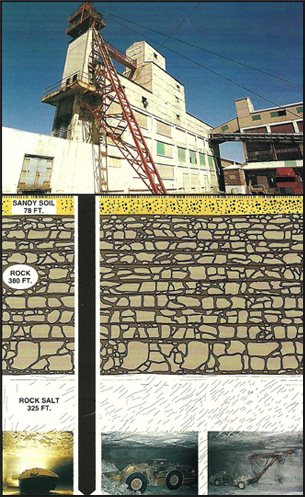![]() Mine: (620) 662-3345 - Office: (620) 856-3332
Mine: (620) 662-3345 - Office: (620) 856-3332
![]() Mine: (620) 662-3345 - Office: (620) 856-3332
Mine: (620) 662-3345 - Office: (620) 856-3332
The purpose of Hutchinson Salt Company begins with integrity. We are a family owned business, located in the heart of Kansas, with a passion to inspire people by allowing growth and development through leadership. Our company is dedicated to creating a safe environment and workplace by investing in our employees and the people we serve. As a working salt mine 650 feet below the Kansas prairie, Hutchinson Salt Company strives to work diligently and safely to offer the highest quality of rock salt for road deicing as well as for agricultural needs.

About 230 million years ago, when dinosaurs roamed the Earth, Kansas was covered by the salt waters of a great inland sea. As the waters from that sea evaporated, the salt remained and was subsequently covered by earth and rock. As the centuries went by, more earth and rock covered the salt bed until the weight and the pressure of the earth was so great that the salt was compressed into solid rock, called Halite.
Before Kansas was settled by Europeans, salt marshes and salt springs were used by wildlife, Native Americans, and early travelers. Wild animals of the plains (especially bison, deer, antelope, and elk) obtained salt from places known as licks. Salt licks, or salt flats, are areas where saline ground water reaches the surface and then evaporates during dry times, leaving salt on the ground. Native Americans, explorers and hunters, and early ranchers obtained salt by eveaporating water collected from salt springs. Early hunters visited the salt marshes to jerk buffalo meat. They would either evaporate brine or dip the meat in pools of strong brine and then dry it in the sunshine or by a fire.
Salt was commercially manufactured in Kansas as early as 1863 at the Osawatomie Salt Works in Miami County in eastern Kansas. Brine, produced from five wells that tapped a saline aquifer, was evaporated in 17 kettles (each holding 30 gallons) set in a single furnace. The salt sold locally for $1.40 per bushel (a bushel of salt weights 56 pounds). About the same time, salt was produced in Republic County at the Tuthill marsh by scraping the salt scale from the marsh, dissolving it in water, and then siphoning off the clear brine. The brine was then evaporated to recover the salt. Salt was sold in nearby Seapo, and hauled to Manhattan, where it sold for as much as ten cents per pound. Other early salt plants were established at Solomon in Dickinson County in 1867.
Rock salt was discovered in central Kansas in 1887 by speculation companies organized to drill for coal gas, oil, or any valuable minerals they might encounter. Although the main objectives were not found in commercial quantities, drillers repeatedly encountered beds of salt several hundred feet thick occurring at shallow depths (500 to 1,000 feet). Rock salt was first mined in Hutchinson in 1888, using solution mining (a mining method that pumps water down wells to dissolve the salt), when two wells and a salt factory were put into operation. By 1891, underground mines (using a mining method similar to underground coal mining) produced salt at Lyons, Kingman, and Kanopolis. Underground mining began at Hutchinson in 1923 when the Carey Salt Mine was officially dedicated. In 1990 the Hutchinson Salt Company was formed and purchased the mine. The mine has constantly modernized and improved its procedures and facilities so that the highest quality product at the most competitive price is always available to our customers.